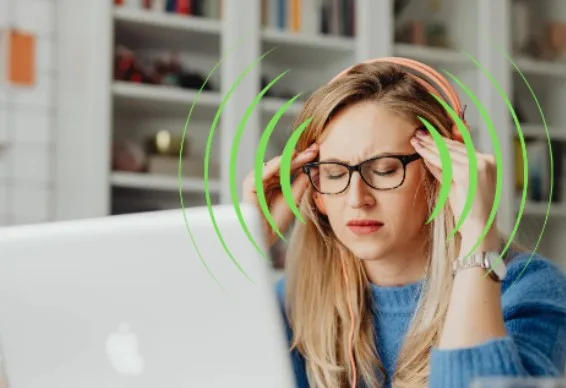Effects of Electromagnetic Fields on Human Health
(updated 01/31/2024)
In the modern age of technology, we are surrounded by a vast network of electromagnetic fields (EMFs), generated by the electronic devices that have become an integral part of our daily lives.
From smartphones and Wi-Fi routers to power lines and household appliances, these invisible waves of energy permeate our surroundings. While these EMFs have undoubtedly revolutionized the way we live, concerns have arisen regarding their potential impact on human health.
In this blog post, we will explore the research surrounding the effects of electromagnetic fields on humans, both the risks and benefits associated with our increasingly connected world.
Then, we will offer proven strategies to minimize EMF exposure and protect ourself from its potential negative effects.
Understanding Electromagnetic Fields:
Electromagnetic fields also called EMFs, are a combination of electric and magnetic fields that propagate as waves. See: Electric & Magnetic Fields
Electromagnetic radiation refers to the energy that travels through space in the form of electromagnetic waves. These waves are created by the movement of electrically charged particles, such as electrons.
Electromagnetic radiation includes a broad spectrum of waves, each characterized by its wavelength and frequency.
Key characteristics of electromagnetic radiation
They include:
Wavelength: The distance between successive peaks (or troughs) of the electromagnetic wave. Wavelength is usually measured in units such as meters or nanometers.
Frequency: The number of oscillations or cycles of the wave that occur in a unit of time. Frequency is measured in hertz (Hz), where 1 Hz equals one cycle per second.
Speed: Electromagnetic waves travel at the speed of light, which is approximately 3 x 10^8 meters per second in a vacuum.
The electromagnetic spectrum
The electromagnetic spectrum is divided into different regions based on wavelength or frequency, and each region corresponds to a different type of electromagnetic radiation. These regions include:
- Radio waves: Long wavelength, low frequency.
- Microwaves: Shorter wavelength and higher frequency than radio waves.
- Infrared radiation: Beyond microwaves, with longer wavelengths than visible light.
- Visible light: The narrow range of wavelengths detectable by the human eye, including the colors of the rainbow.
- Ultraviolet radiation: Beyond visible light, with shorter wavelengths than visible light.
- X-rays: Shorter wavelength and higher frequency than ultraviolet radiation.
- Gamma rays: Shortest wavelength, highest frequency, and most energetic electromagnetic radiation.
Electromagnetic radiation plays a crucial role in various natural and technological processes. However, excessive exposure to certain types of electromagnetic radiation can have health implications, and precautions are often taken to minimize such exposure. See: Electromagnetic field
EMFs can be categorized into two main types: ionizing and non-ionizing.
- Ionizing radiation, such as X-rays and gamma rays, has enough energy to ionize atoms and potentially damage DNA.
- Non-ionizing radiation, on the other hand, includes the lower-energy forms like radiofrequency (RF) radiation and extremely low-frequency (ELF) radiation, which are typically emitted by everyday electronic devices.

What emits EMF?
Various devices emit (EMFs) as part of their normal operation. Here are some common devices that emit electromagnetic fields:
Mobile Phones: Cell phones emit radiofrequency (RF) electromagnetic fields when in use. The intensity of the radiation depends on factors like signal strength, distance from the cell tower, and how the phone is used.
Wi-Fi Routers: Wireless routers emit radiofrequency electromagnetic fields to enable wireless communication with devices such as smartphones, laptops, and tablets.
Microwaves: Microwave ovens emit electromagnetic radiation in the microwave frequency range to cook or heat food. However, the design of these devices is such that the radiation is contained within the oven.
- Power Lines: High-voltage power lines and electrical wiring in homes emit electromagnetic fields due to the flow of electric current. The strength of the fields decreases with distance from the source.
Television and Computer Screens: Cathode ray tube (CRT) televisions and computer monitors emit electromagnetic radiation, but newer LCD and LED screens emit lower levels.
Fluorescent Lights: Certain types of fluorescent lights generate electromagnetic fields when in operation.
Bluetooth Devices: Devices that use Bluetooth technology, such as wireless headphones and speakers, emit electromagnetic fields for short-range wireless communication.
Household Appliances: Many household appliances, including refrigerators, washing machines, and vacuum cleaners, generate electromagnetic fields while in use.
Power Tools: Some power tools, especially those with electric motors, emit electromagnetic fields during operation.
It’s important to note that not all electromagnetic fields are harmful. Many devices generate low-level electromagnetic fields as part of their normal functioning.
However, concerns have been raised about potential health effects from prolonged exposure to high levels of certain types of electromagnetic radiation, especially those emitted by mobile phones and other wireless devices.
Research is ongoing in this area, and regulatory bodies set safety standards to limit exposure to electromagnetic fields.
Potential Health Risks of electromagnetic fields
In an increasingly technology-driven world, concerns about the potential health effects of electromagnetic fields (EMFs) are resurfacing.
EMF exposure and electrosensitivity
Researchers sought a large sample size and used rigorous methodologies to measure EMF exposure levels and assess electrosensitivity symptoms, such as headaches, fatigue and sleeping troubles.
In fact, some people report suffering from electrosensitivity, a condition characterized by a variety of symptoms, including headaches, fainting, heart rhythm problems, joint and muscle pain, and more.
Although further research is needed to confirm a causal relationship, anecdotal evidence suggests a potential link between EMF exposure and these symptoms.
Does Cell Phone Radiation Cause Cancer?
One of the most debated topics is the potential link between exposure to EMFs and the development of cancer. Numerous studies have investigated this association, particularly in relation to mobile phones and their associated RF radiation.
The World Health Organization (WHO) classifies RF radiation as a Group 2B possible carcinogen, suggesting that there is limited evidence of its carcinogenicity to humans. (?)
However, many experts are calling for further research to establish a clearer understanding. See Do Mobile Phones Affect Brain Function?
Neurological Effects of EMFs:
With the rise in mobile phone usage, concerns have been raised about the possible neurological effects of prolonged exposure to RF radiation.
Some studies suggest a correlation between mobile phone use and an increased risk of certain neurological conditions, such as glioma and acoustic neuroma. However, the existing body of evidence is not yet robust enough to establish a clear causal relationship.
For more on cell phones and Wi-Fi, check out these other videos:
Electromagnetic fields and Alzheimer’s disease:
Recent research has revealed a possible link between electromagnetic fields and Alzeimer’s disease: A study conducted at Washington State University suggests a correlation between EMF exposure, calcium and Alzheimer’s disease. See New insights into the link …
Researchers exposed mice to the equivalent of EMFs experienced by humans from cell phones and found increased production of beta-amyloid proteins, which contribute to plaque formation in the brains of AD patients. ‘Alzheimer’s.
In addition, high exposure to EMF could be the cause of early cases of Alzheimer’s disease.
Although these results provide valuable information, it is essential to remember that additional research is needed to obtain conclusive evidence on the direct impact of electromagnetic fields on Alzheimer’s disease in humans.
(7 years ago ↵ )
EMFs Impact on Fertility:
Another area of concern is the potential impact of EMFs on reproductive health. Some studies have explored the connection between prolonged exposure to EMFs and decreased fertility.
However, more research is needed to draw definitive conclusions. Similarly, the effects of EMFs on pregnancy outcomes remain a topic of ongoing investigation.
Diverse Health Effects of EMF’s: Why 5G Will Be Much Worse
Summary of the effects on health by Dr. Pall from the Washington State University
Potential Health Benefits:
Therapeutic Applications:
While concerns about the negative effects of EMFs persist, it’s essential to acknowledge the positive applications of electromagnetic fields in medicine. Electromagnetic therapy, also known as magnetotherapy, involves the use of electromagnetic fields for therapeutic purposes. This approach has shown promise in various medical conditions, including pain management, wound healing, and bone regeneration. The controlled application of specific electromagnetic frequencies has been demonstrated to have beneficial effects on the human body.
Diagnostic Imaging:
In the realm of healthcare, electromagnetic fields play a crucial role in diagnostic imaging technologies such as magnetic resonance imaging (MRI). MRI utilizes strong magnetic fields and radio waves to generate detailed images of internal structures within the body. This non-invasive technique has become an indispensable tool in medical diagnostics, allowing for the detection and characterization of a wide range of conditions without exposing patients to ionizing radiation.
Everyday Convenience:
The pervasive use of electronic devices in our daily lives, while raising concerns, has also brought about unprecedented convenience and connectivity. From communication and information access to entertainment and productivity, the benefits of living in a digitally connected world are undeniable. Striking a balance between reaping these advantages and mitigating potential health risks remains a key challenge for individuals and society as a whole.
How to reduce the effects of electromagnetic fields on us
Minimizing EMF exposure: Evidence-based recommendations and strategies – especially from common sources like mobile phones and Wi-Fi devices. Here are some general suggestions:
Reduce exposure to EMFs
Maintain Distance:
- Keep a safe distance from devices that emit EMFs, such as mobile phones, Wi-Fi routers, and power lines.
- Use speakerphone or a wired headset to keep your mobile phone away from your head during calls.
Limit Wireless Device Use:
- Use wired connections whenever possible instead of wireless connections.
- Turn off Wi-Fi on your devices when not in use.
- Limit the use of wireless headphones and other Bluetooth devices, such as cell phones, tablets and laptops can significantly reduce your exposure to EMFs
- Create EMF-Free Zones:
- Designate certain areas in your home or workspace as EMF-free zones, especially in sleeping areas or relaxation areas. Minimizing exposure during sleep can be particularly beneficial, as sleep is crucial to overall health. Turn off all devices, especially wifi!! Don’t keep your phone near you at night even if it’s in airplane mode!
- Try setting screen-free periods, especially during meals.
- Turn off electronic devices when not in use.
Use Airplane Mode:
- When not actively using the wireless capabilities of your mobile device, consider putting it in airplane mode to reduce EMF emissions.
EMF protection
Use Shielding Products:
- Some people use EMF shielding products, such as EMF’s shields, phone cases, clothing, or bed canopies, designed to reduce exposure. However, it is important to carefully evaluate the effectiveness and reliability of these products before use. Look for reliable sources and consult professionals in the field for advice.
Choose Low-EMF Devices:
- When purchasing electronic devices, consider choosing those with lower EMF emissions. Check the manufacturer’s specifications for information on SAR (Specific Absorption Rate) for mobile phones, for example.
- Use Wired Devices:
- Opt for wired connections for internet and phone services when possible, such as using Ethernet cables instead of Wi-Fi.
Stay informed
Educate Yourself:
- Stay informed about the potential sources of EMF in your environment and understand the specific recommendations for each type of electromagnetic radiation.
- Consider implementing strategies such as turning off Wi-Fi at night, keeping cell phones away when not in use, and using a wired speaker or headphones to reduce the number of devices near you, especially your head.
Consult Professionals:
- If you have specific concerns or health issues related to EMF exposure, consider consulting with a healthcare professional or EMF consultant for personalized advice.
It’s important to note that the majority of scientific studies have not provided conclusive evidence of harmful effects from everyday exposure to typical levels of EMFs. However, if you have specific health concerns or if you are part of a vulnerable population, it’s advisable to consult with healthcare professionals for personalized advice based on your individual circumstances.

As we navigate the complexities of our modern, technologically driven world, the effects of electromagnetic fields on human health continue to be a subject of intense scrutiny and debate.
While there are legitimate concerns about potential risks, it’s crucial to approach the topic with a nuanced understanding that considers both the potential harms and benefits.
It is crucial to take a balanced and proactive approach when managing EMF exposure.
By implementing evidence-based strategies, such as reducing wireless device use, creating EMF-free zones, and using protective products, individuals can take proactive steps to manage their exposure and protect yourself.
Remember, staying informed and proactive is essential to ensuring your well-being in our technology-driven world.



